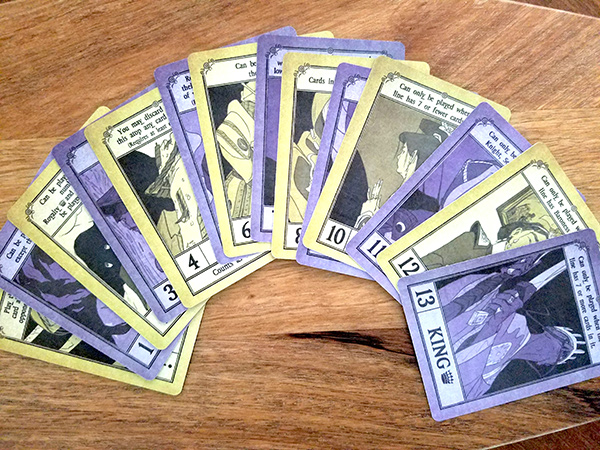Preview: Start as a Lowly Assassin and Become a Beloved King in Hierarchy

Button Shy introduces a quick 14-card take on War with its latest game, coming soon to Kickstarter.
Gameplay
Hierarchy is a two player game featuring 14 double-sided cards. Each card represents one character and value. Cards are shuffled and then dealt to each player, with the designated purple player turning their cards to the purple side and designated gold player turning their cards to the gold side. Then players will lay out their cards for the other player to see.
Players will take turns playing their cards, each trying to play a card with a higher value than the last card played, similar to the classic card game War. However, Hierarchy throws a wrench into this traditional gameplay by giving each character a unique power or action. While the first player may decide to play their purple Assassin with a value of one, followed by the gold player laying down a Leper with a value of two, this would ignore the variable powers of each card that provides flexibility beyond each card’s set values. For example, the Assassin allows players to play it on top of any card except the Leper or the Tower (with a base value of four). Then there’s the Doppleganger, which has no value but allows players to copy the opponent's previously played card (so long as it’s not the current top card in the pile).
The goal is to be the last player standing with a card that can be played. If a player runs out of cards or cannot legally play any remaining cards, they lose the game.

Review
Hierarchy has its roots in traditional card games where players are trying to topple an opponent by playing a higher value or suit. Yet, Hierarchy also relies on trading card game mechanics or even something as boiled down as the Silver series of card games from Bezier. The variable powers each character possess makes gameplay unpredictable, even though each player is playing from a row of face-up cards their opponent can see.
Likewise, only having one card of each character creates variable gameplay. The luck of the deal will change every game and how each player strategizes. In some games, being the first player will give a distinct advantage and in others, it may feel like a heavy disadvantage. This is the essence of gaming: to always feel behind and to somehow persevere and overcome obstacles to find a path to competitive victory.
The only complaint is how rudimentary the reference cards are written. It should be noted the game is still in its final stages of prototyping, but the loose use of language (“atop” versus “in a line”) can make it confusing as to how the game should be played. Should higher values be played on top or should cards follow a line so that previously played cards can be seen and deduced?
This is a minor quibble for a game that is both uncomplicated and overly complicated in its presentation and gameplay. While the objective is so simple, the paths to achieving it are rife with pitfalls and mistakes to avoid. Whether as an aid to prepare your children for more cutthroat gameplay mechanics or as an enjoyable filler on game nights or dinner dates, Hierarchy is another strong entry in Button Shy’s line of card games that rethink the limits of limitations.
Pros: Easy to learn, complex strategy, each game is different from the last
Cons: Reference cards need uniform terms and language
Disclaimer: We received a complimentary prototype for review




